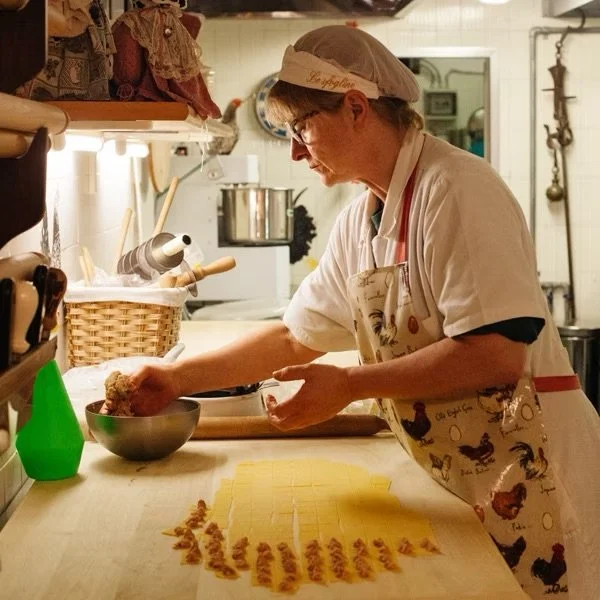FOOD + WINE Q & A
with
Emiko Davies
Emiko Davies is an Australian-Japanese food writer, photographer and cookbook author, based in Tuscany for the past 20 years.
Join Emiko this October on a trip to the gastronomic heart of Italy, as she sips and savors her way through this food lover’s paradise,
sharing recipes, hidden gems and her favorite local makers.
But first, let's get to know a little more about her.
You have cookbooks on Italian food and Japanese food, are there any commonalities you've found or cross over dishes you've created?
I find so many things are similar, even though they are a world apart. To begin with, look at the geography and shape of the countries — Italy is a peninsula surrounded by the sea and Japan is a long series of islands, surrounded also by the sea. Both are mountainous and volcanic, blessed with abundant seafood and a wonderful variety of high quality produce, thanks to their positions and their fertile soils.
My theory is that because their ingredients are so good, there is very little messing about with them and so the main similar thing about these two cuisines is that they are inherently simple — you just let the produce shine and enhance it with some deeply umami flavours.
Tell us a bit about your story and career path, how did you get to San Miniato?
I originally came to Florence to study etching the senior year of my Bachelor of Fine Art and I fell in love with the city. So I came back in 2005 to work for a year and study art restoration — but I soon met my husband Marco, I settled in and I never left. It felt like home. At a certain point I started writing a blog where I shared what Tuscan food was really about — food, words and photography have long been passions of mine — and I realized this is what I really loved doing. Things just took off from there!
I started writing cookbooks (my first cookbook came out in 2016, now I have written seven). Although Florence was my home for a long time, during lockdown we decided to move to San Miniato, Marco’s hometown, to be closer to his family and get out of touristy Florence and I have never looked back.
Here, we have been able to do things we could never have done in Florence, including owning a home and opening our own business (a wine bar and cooking school). We have a great community of producers and other like-minded food people, our kids can grow up in a town where they know everyone and where they feel safe. We love it.
Do you have any favorite ingredients or flavor profiles, that when you see them you automatically think, yes, I'm ordering that or at the market if you see it, you grab it?
Oh so many things — monks beard, a snappy, grassy spring vegetable that looks like how I imagine mermaid hair that comes from Emilia Romagna, delicious with garlic and chilli; wild strawberries that taste like candy; fresh borlotti or cannellini beans in the summer and early fall (their texture is incredible, something that you lose completely with dried or canned versions) and artichokes, both in the fall and the spring, I can never go past them!
You have a focus on natural wine. What is it about this type of wine that you find most interesting?
There are many reasons we champion natural wine, one being that we love to drink wine — but we don’t want to drink poison. For the same reason that we choose organic produce over conventional produce that has been sprayed with chemicals and we appreciate artisanal cheese over, say, Kraft sliced cheese, we also want that for what we drink.
What we personally look for in food and in wine is the same: as little fiddling around as possible. Unprocessed, little or no additives, always organic, possibly biodynamic, sustainable, made by people who are artisans, who care about the details and have a connection to the territory, to their plants and traditions. We find winemakers that put thought and care for the product and for the land into their bottles.
But we are also picky, of course, it has to be absolutely delicious and fault free, which unfortunately plenty of natural wine is not. I’d go as far to say as there are lots of bad natural wines out there that has given natural wine a bad name or a connotation of “funky”, which is not necessarily a good thing. We like this alternative definition of natural wine: Nothing is added and nothing is taken away.
Think of it this way, even an amateur cook can follow a recipe and it can turn out okay but to take an ingredient and make it shine and express itself fully, while doing as little as possible to it, you really need to know what you are doing and you need to do it well. And this is where potential quality comes from, along with the fruit itself — and starting with grapes that are organic or biodynamic and hand-picked are just the beginning.
You teach workshops all over Italy, what do you think is special about the food and wine from the Emilia Romagna region.
It’s undeniable that Emilia Romagna is the gastronomic heart of Italy, so for people who loves Italian cuisine and traditions as much as we do, exploring this region is a must. It’s the home of some of the best icons of Italian food — Parmesan cheese, prosciutto, culatello, balsamic vinegar, tortellini. There is so much to love!
It’s also the home state of many important food figures in Italy, which I think is no coincidence. Pellegrino Artusi, the “great-grandfather” of Italian cuisine and the author of Italy’s most famous cookbook, Science in the Kitchen and the Art of Eating Well, Marcella Hazan, the doyenne of Italian cuisine and Massimo Bottura, Italy’s most famous contemporary chef — to name a few — are all from here.
What are you most excited to teach or share on your trip to the Emilia Romagna?
I’m particularly excited about showing people some lesser known parts of Italy and lesser known foods, even — culatello for example. Here in Italy it is known as the “king of salumi” and is a precious Slow Food presidium but I think outside of Italy most people have never heard of it.
I love that this product is so strictly tied to the place where it was created, a place so close to the river Po and its swampy lands that it’s constantly surrounded by thick fog. This fog, that could have been a hinderance for curing and air drying meat, became such an important part of the process of making culatello that it is basically an ingredient.
Only 23 producers exist and only 8 that qualify for Slow Food. We will visit an incredible underground labyrinth of culatello in a centuries old farm run by one of the most talented chefs in Italy — it’s so special.
Are there any common mistakes you think people make when they visit Italy? Or things you think, oh, you're missing the best parts of Italy if you don't....
I think the most common mistake I see is when they tend to try to pack too much in and cover too much ground in a short amount of time — I get it, as an Australian we tend to think, oh a 2 hour drive away, that’s easy, but in Italy, visiting towns that are 2 hours apart is like visiting 2 totally different countries! Here, even the town 15 minutes away is a whole different place, with a unique personality and a unique dish that you can only get there. I think there is so much to get out of a slower way of traveling and spending more time in one area, getting to know one region, rather than trying to see the whole country in a handful of days.

























